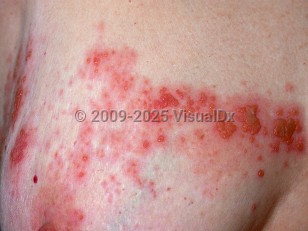Herpes zoster in Child
See also in: Cellulitis DDx,Anogenital,Hair and Scalp,Oral Mucosal LesionAlerts and Notices
Important News & Links
Synopsis

Involvement of the ophthalmic branch of the trigeminal nerve may lead to herpes zoster ophthalmicus. Herpes zoster oticus (Ramsay-Hunt syndrome) occurs with involvement of the vestibulocochlear nerve. Herpes zoster duplex is the simultaneous occurrence of zoster in 2 noncontiguous dermatomes and herpes zoster multiplex refers to this phenomenon occurring in more than 2 dermatomes. While most patients with herpes zoster duplex or multiplex are adults, children affected by this condition have also been reported.
Although the onset of cutaneous zoster in adults typically involves a 1- to 3-day prodrome of burning pain or tingling in the affected dermatome, this is rarely observed in children. Postherpetic neuralgia is also rare in children. Other less frequently encountered post-zoster sequelae include herpes zoster granulomatous dermatitis.
If it occurs, zoster encephalitis usually appears in the first 2 weeks after the onset of lesions and has a 10%-20% mortality rate. Disseminated zoster occurs 5-10 days after the onset of dermatomal disease. It is defined as more than 20 lesions outside the initial dermatome of involvement.
Immunocompromised patient considerations: Immunocompromised patients have a higher risk of disseminated zoster. In patients with HIV and AIDS, multidermatomal, necrotic, or recurrent zoster may occur. Persistent ulcers and chronic hyperkeratotic zoster are further manifestations. A strong association of herpes zoster multiplex with underlying malignancy (especially lymphoma) was reported in one retrospective study.
Codes
B02.9 – Zoster without complications
SNOMEDCT:
4740000 – Herpes zoster
Look For
Subscription Required
Diagnostic Pearls
Subscription Required
Differential Diagnosis & Pitfalls

Subscription Required
Best Tests
Subscription Required
Management Pearls
Subscription Required
Therapy
Subscription Required
Drug Reaction Data
Subscription Required
References
Subscription Required
Last Updated:09/16/2024
 Patient Information for Herpes zoster in Child
Patient Information for Herpes zoster in Child- Improve treatment compliance
- Reduce after-hours questions
- Increase patient engagement and satisfaction
- Written in clear, easy-to-understand language. No confusing jargon.
- Available in English and Spanish
- Print out or email directly to your patient


